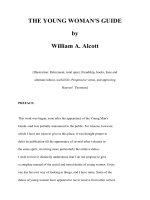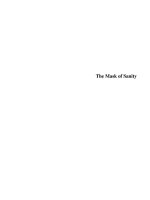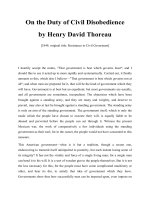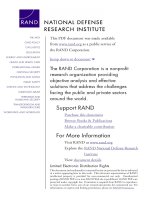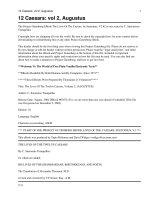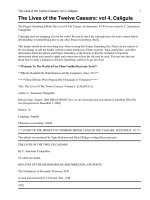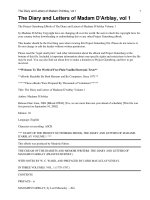The MORAL LIMITS VOLUME TWO pot
Bạn đang xem bản rút gọn của tài liệu. Xem và tải ngay bản đầy đủ của tài liệu tại đây (31.76 MB, 351 trang )
OFFENSE
TO
OTHERS
The
MORAL LIMITS
VOLUME
TWO
NEW
YORK
OXFOR D
of
the
CRIMINAL
LAW
Offense
to
Others
JOEL
FEINBERG
OXFORD
UNIVERSITY
PRESS
W
1985
1985
Oxford
University Press
Oxford
New
York
Toronto
Delhi Bombay Calcutta Madras Karachi
Petaling Jaya Singapore
Hong
Kong
Tokyo
Nairobi
Dar es
Salaam Cape
Town
Melbourne Auckland
and
associated companies
in
Beirut Berlin Ibadan Nicosia
Copyright
©
1085
by
Oxford University Press, Inc.
First
published
in
1985
by
Oxford University Press, Inc.,
198
Madison Avenue,
New
York,
New
York
10016-4314
First
issued
as an
Oxford University Press paperback,
1987
Oxford
is a
registered trademark
of
Oxford University
Press
All
rights reserved.
No
part
of
this publication
may be
reproduced,
stored
in a
retrieval system,
or
transmitted,
in any
form
or by any
means,
electronic, mechanical, photocopying, recording,
or
otherwise,
without
the
prior permission
of
Oxford University Press, Inc.
Library
of
Congress Cataloging
in
Publication
Data
Feinberg,
Joel,
1926-
The
moral limits
of the
criminal law.
Includes index.
Contents:
v.
i.
Harm
to
others—
v. 2.
Offense
to
others,
i.
Criminal
law—Philosophy.
2.
Criminal
law—Moral
and
religious aspects.
I.
Title.
K5oi8.F44
1985
34511.001
83-13431
ISBN
o-i9~503449-X
342.5001
ISBN
0-19-505215-3
(PPBK)
6 8
10
9 7 5
Printed
in
the
United States
of
America
For
Betty
again
This page intentionally left blank
3
About
the
Longer
Work
Offense
t o
Others
is the
second
volume
in a
four-volume work,
Th e
Moral
Limits
of
the
Criminal Law.
The
subsequent volumes will
be
published sepa-
rately
at
short intervals, each with
a
brief synopsis
of the
earlier volumes.
Volume one, Harm
t o
Others,
discusses
the
concept
of
harm,
its
relation
to
interests, wants, hurts, offenses, rights,
and
consent; hard cases
for the
application
of the
concept
of
harm, like "moral harm," "vicarious harm,"
and
"posthumous harm";
the
status
of
failures
to
prevent harm;
and
prob-
lems involved
in
assessing, comparing,
and
imputing harms. Volume
three,
Harm
t o
Self,
will discuss
the
problems
of
legal paternalism,
the
nature
of
personal autonomy,
and the
concept
of
voluntariness.
Volume
four,
Harm-
less
Wrongdoing,
will discuss critically various positions
often
lumped indis-
criminately under
the
heading "legal
moralism,"
including
the
claims that
criminal
prohibitions
can be
justified
by
their role
in
preserving
a way of
life,
enforcing true morality, preventing wrongful gain from exploitation
even
when
it has no
proper
"victim,"
and
elevating taste
and
perfecting
character.
This page intentionally left blank
3
Synopsis
of
Volume
One
The
basic question
of the
longer work that volume
one
introduces
is a
deceptively simple one: What sorts
of
conduct
may the
state rightly make
criminal?
Philosophers have attempted
to
answer this question
by
propos-
ing
what
I
call
"liberty-limiting principles"
(or
equivalently, "coercion-legi-
timizing
principles") which state that
a
given type
of
consideration
is
always
a
morally relevant reason
in
support
of
penal legislation even
if
other rea-
sons
may in the
circumstances outweigh
it.
Each volume
of The
Moral
Limits
of
th e
Criminal
Law
corresponds
to a
leading liberty-limiting principle (but
see the
longer list, with definitions,
of ten
such principles
at the end of
this
synopsis).
The
principle that
the
need
to
prevent harm
to
persons other
than
the
actor
is
always
a
morally relevant reason
in
support
of
proposed
state coercion
I
call
th e
harm
t o
others
principle
("the harm principle"
for
short).
At
least
in
that vague formulation
it is
accepted
as
valid
by
nearly
all
writers. Controversy arises when
we
consider whether
it is the
only
valid
liberty-limiting principle,
as
John
Stuart Mill declared.
Three
other coercion-legitimizing principles,
in
particular, have
won
wide-
spread support.
It has
been held (but
not
always
by the
same person) that
it
is
always
a
good
and
relevant reason
in
support
of
penal legislation that
(i)
it
is
necessary
to
prevent hurt
or
offense
(as
opposed
to
injury
or
harm)
to
others (the
offense
principle);
(2) it is
necessary
to
prevent harm
to the
very
person
it
prohibits from acting,
as
opposed
to
"others"
(legalpaternalism);
(3)
it
is
necessary
to
prevent inherently immoral conduct whether
or not
such
conduct
is
harmful
or
offensive
to
anyone
(legal
moralism).
I
denned
"liberal-
ix
X
SYNOPSI S
O F
VOLUM E
ON E
ism"
in
respect
to the
subject matter
of
this book
as the
view that
the
harm
and
offense
principles, duly clarified
and
qualified,
between them exhaust
the
class
of
morally relevant reasons
for
criminal prohibitions. ("Extreme
liberalism"
rejects
the
offense principle too, holding that only
the
harm
principle
states
an
acceptable reason.)
I
then candidly expressed
my own
liberal
predilections.
The
liberal program
of
this work
is
twofold. Volumes
one and two
propose interpretations
and
qualifications
of the
liberal liberty-limiting
principles
that
are
necessary
if
those
two
principles
are to
warrant
our
endorsement (assuming from
the
start that they
do
warrant endorsement).
Assuming that
the
harm
and
offense
principles
are
correct,
we
ask,
how
must
those principles
be
understood? What
are we to
mean
by the key
terms "harm"
and
"offense",
and how are
these vague principles
to be
applied
to the
complex problems that actually arise
in
legislatures? Volumes
one and two
attempt
to
define,
interpret,
qualify,
and
buttress liberalism
in
such ways that
in the end we can say
that
the
refined
product
is
what
liberalism
must
be to
have
its
strongest
claim
to
plausibility,
and to do
this
without
departing
drastically
from
the
traditional usage
of the
liberal label
or
from
the
motivating spirit
of
past liberal writers, notably
John
Stuart Mill.
The
second part
of the
liberal program,
to
which Volumes three
and
four
are
devoted,
is to
argue against
the
non-liberal principles (especially pater-
nalism
and
moralism) that many writers claim must supplement
the
liberal
principles
in any
adequate theory.
Volume
one
then
proceeds
to ask
what
is the
sense
of
"harm"
in the
harm
principle
as we
shall understand
it in
this work.
I
distinguish
at the
outset
a
non-normative sense
of
"harm"
as
setback
to
interest,
and a
normative sense
of
"harm"
as a
wrong,
that
is a
violation
of a
person's rights. Examples
are
given
of
rare "non-harmful
wrongs,"
that
is
wrongs that
do not set
back
the
wronged party's interests,
and
more common "non-wrongful harms," that
is
setbacks
to
interest, like those
to
which
the
"harmed
party"
consented, that
do not
violate
his
rights. Neither
of
these will count
as
"harms"
in the
sense
of
the
harm principle. Rather, that sense will represent
the
overlap
of the
other
two
senses,
and
apply only
to
setbacks
of
interests that
are
also
wrongs,
and
only
to
wrongs that
are
also setbacks
to
interests. Chapters
i
and 2 are
devoted
to
problems about harm that stem from
its
character
as a
setback
to
interest, while Chapter
3
discusses
in
more detail
the
features
of
harmful
acts that stem from their character
as
violations
of
rights.
Chapter
2
discusses hard cases
for the
application
of the
concept
of
harm:
Does
it
make sense
to
speak
of
"moral harm," "vicarious harm,"
"posthu-
mous
harm,"
or
"prenatal harm"? First,
can we
harm
a
person
by
making
SYNOPSIS
O F
VOLUME
ON E x i
him
a
worse person than
he was
before?
Plato insisted that "moral harm"
is
harm (and severe harm) even when
it
does
not set
back
interests.
But our
analysis
of
harm denies Platonism.
A
person does
not
necessarily become
"worse
off" when
he
becomes "worse";
he is
"morally harmed" only
if he
had
an
antecedent interest
in
having
a
good character.
Second,
can we
harm
one
person
by
harming another?
This
question
I
answer
in the
affirmative.
A
causes "vicarious harm"
to
B
when
B has an
interest
in (7s
welfare
or in
(7s
character,
and A.
then directly harms
or
corrupts
C.
Third,
can a
person
be
harmed
by his own
death
or by
events that occur
after
his
death?
These
questions raise
extremely
subtle problems that
defy
brief summary.
My
conclusion, however,
is
that death
can be a
harm
to the
person
who
dies,
in
virtue
of the
interests
he had
ante-mortem
that
are
totally
and
irrevocably
defeated
by his
death. Posthumous harm
too can
occur, when
a
"surviving
interest"
of the
deceased
is
thwarted
after
his
death.
The
subject
of a
surviving
interest,
and of the
harm
or
benefit
that
can
accrue
to it
after
a
person's death,
is the
living
person ante-mortem whose interest
it
was.
Events
after
death
do not
retroactively produce
effects
at an
earlier time
(as
this
account
may at first
suggest),
but
their occurrence
can
lead
us to
revise
our
estimates
of an
earlier person's well-being,
and
correct
the
record before
closing
the
book
on his
life.
As for
prenatal harms,
I
argue that fetuses (even
if
they
are not yet
persons)
can be
harmed
in the
womb,
but
only
on the
assumption that they
will
eventually
be
born
to
suffer
the
harmful
consequences
of
their prenatal
injuries.
People
can
also
be
harmed
by
wrongful actions that occurred
before
they were even conceived, when
the
wrongdoer deliberately
or
negli-
gently initiated
a
causal sequence that
he
might have known would
injure
a
real
person months
or
years later.
I
even conceded that
in
certain unusual
circumstances
a
person might
be
harmed
by the act of
being given birth
when that
was
avoidable.
I
denied, however, that
a
person
can be
harmed
by the
very
act of
sexual congress that brings
him
into existence unless
he is
doomed thereby
to be
born
in a
handicapped condition
so
severe that
he
would
be
"better
off
dead."
If a
child
was
wrongfully conceived
by
parents
who
knew
or
ought
to
have known that
he
would
be
born
in a
handicapped
condition less severe than that, then
he
cannot later complain that
he was
wronged,
for the
only alternative
to the
wrongful conception
was for him
never
to
have come into existence
at
all,
and he
would
not
have preferred
that.
If
parents
are to be
legally punished
for
wrongfully
bringing other
persons into existence
in an
initially
handicapped condition,
but one
that
is
preferable
to
nonexistence,
it
will
have
to be
under
the
principle
of
legal
moralism.
The
harm principle won't stretch that far.
Xll
SYNOPSI S
O F
VOLUM E
ON E
Another
difficult
analytic question, discussed
in
Chapter
4, is
whether
the
harm principle will
stretch
to
cover blamable
failures
to
prevent harm.
I
consider
the
standard arguments
in the
common
law
tradition against
so-
called
"bad Samaritan statutes" that require persons
to
undertake "easy
rescues" under
threat
of
legal punishment
for
failure
to do so. I
reject
all of
these arguments
on the
grounds either that they systematically confuse
active
aid
with gratuitous benefit,
or
that they take
far too
seriously
the
problem
of
drawing
a
non-arbitrary line between reasonably easy
and
unre-
asonably
difficult
rescues. (Similar line-drawing problems exist throughout
the
law,
and
most have been found manageable.)
I
conclude then that
requiring
people
to
help prevent harms
is
sometimes
as
reasonable
a
legal
policy
as
preventing
people,
by
threat
of
punishment, from actively causing
harms.
The
more
difficult
question
is
whether this conclusion marks
a
departure
from
the
harm principle
as
previously defined.
I
argued that
it
does not, partly
on the
ground that omissions, under some circumstances,
can
themselves
be the
cause
of
harms.
To
defend
that
contention,
I
must
rebut powerful arguments
on the
other side,
and in the final
section
of
Chapter
4 I
attempt
to do so.
The final two
chapters
(5 and 6) of
Volume
one
attempt
to
formulate
"mediating maxims"
to
guide
the
legislature
in
applying
the
harm principle
to
certain especially complicated kinds
of
factual
situations.
Its
formulation,
up
to
that point,
is so
vague that without further guidance there
may be no
way
in
principle
to
determine
how it
applies
to
merely minor harms, mod-
erately
probable harms, harms
to
some interests preventable only
at the
cost
of
harms
to
other interests irreconcilable with them, structured com-
petitive
harms, imitative harms, aggregative harms, accumulative harms,
and
so on. I
argue
for
various supplementary criteria
to
govern
the
applica-
tion
of the
harm principle
to
these
difficult
problems, thus giving
its
bare
bones some normative
flesh and
blood.
These
supplementary guides take
a
variety
of
forms. Some
are
themselves independent moral principles
or
rules
of
fairness.
Others
apply rules
of
probability
or
risk assessment.
Others
are
common-sense maxims such
as the
legal
de
minimis rule
for
minor
harms.
Others
distinguish dimensions
of
interests
to be
used
in
comparing
the
relative "importance"
of
conflicting harms
in
interest-balancing,
or for
putting
the
"interest
in
liberty" itself
on the
scales.
Others
are
practical
rules
of
institutional regulation
to
avoid
the
extremes
of
blanket permission
and
blanket prohibition
in the
case
of
aggregative
and
accumulative harms.
As
a
consequence
of
these
and
other mediating maxims,
the
harm principle
begins
to
lose
its
character
as a
merely vacuous ideal,
but it
also loses
all
semblance
of
factual
simplicity
and
normative
neutrality.
SYNOPSIS
O F
VOLUME
ON E
xii i
Definitions
of
Liberty-limiting Principles
/.
Th e
Harm
Principle:
It is
always
a
good reason
in
support
of
penal
legislation
that
it
would probably
be
effective
in
preventing (eliminat-
ing, reducing) harm
to
persons other than
the
actor (the
one
prohibited
from
acting)
and
there
is
probably
no
other means that
is
equally
effec-
tive
at no
greater cost
to
other
values.*
2.
Th e
Offense
Principle:
It is
always
a
good reason
in
support
of a
proposed
criminal
prohibition that
it is
probably necessary
to
prevent serious
offense
to
persons other than
the
actor
and
would probably
be an
effective
means
to
that
end if
enacted.t
j.
Th e
Liberal
Position
(on the
moral limits
of the
criminal
law):
The
harm
and
offense
principles, duly
clarified
and
qualified,
between them
ex-
haust
the
class
of
good reasons
for
criminal prohibitions. ("The
extreme,
liberal
position"
is
that only
the
harm principle states
a
good
re-
ason
. . .)
4.
Legal
Paternalism
(a
view excluded
by the
liberal position):
It is
always
a
good reason
in
support
of a
prohibition that
it is
probably necessary
to
prevent harm (physical, psychological,
or
economic)
to the
actor him-
self.
5.
Legal
Moralism
(in the
usual
narrow sense):
It can be
morally legitimate
to
prohibit conduct
on the
ground that
it is
inherently immoral, even
though
it
causes neither harm
nor
offense
to the
actor
or to
others.
6.
Moralistic
Legal
Paternalism
(where paternalism
and
moralism overlap
via
the
dubious notion
of a
"moral
harm"):
It is
always
a
good reason
in
support
of a
proposed prohibition that
it is
probably necessary
to
pre-
vent
moral
harm
(as
opposed
to
physical, psychological,
or
economic
harm)
to the
actor himself. (Moral harm
is
"harm
to
one's character,"
"becoming
a
worse person,"
as
opposed
to
harm
to
one's
body, psyche,
or
purse.)
7.
Legal
Moralism
(in the
broad sense):
It can be
morally legitimate
for the
state
to
prohibit certain types
of
action that cause neither harm
nor
offense
to
anyone,
on the
grounds that such actions constitute
or
cause
evils
of
other ("free-floating") kinds.
*The
clause following "and"
is
abbreviated
in the
subsequent
definitions
as "it is
probably
necessary
for . . .
,"
or
"the
need
to . .
."
Note
also
that
part
of a
conjunctive
reason
("effective
and
necessary")
is
itself
a
"reason,"
that
is,
itself
has
some
relevance
in
support
of the
legisla-
tion.
tThe
clause following "and"
goes
without saying
in the
subsequent definitions,
but it is
understood.
All of the
definitions have
a
common
form:
X is
probably necessary
to
achieve
Y
(as
spelled
out in
definition
i)
and is
probably
an
effective
means
for
producing
K
(as
stated
explicitly
in
definitions
i
and 2).
xiv
SYNOPSIS
OF
VOLUME
ONE
8. Th e
Benefit-to-Others
Principle:
It is
always
a
morally relevant reason
in
support
of a
proposed prohibition that
it is
probably necessary
for the
production
of
some
benefit
for
persons
other
than
the
person
who is
prohibited.
9.
Benefit-Conferring
Legal
Paternalism:
It is
always
a
morally relevant rea-
son in
support
of a
criminal prohibition that
it is
probably necessary
to
benefit
the
very person
who is
prohibited.
10.
Perfectionism
(Moral Benefit
Theories):
It is
always
a
good reason
in
support
of a
proposed
prohibition that
it is
probably necessary
for the
improvement (elevation, perfection)
of the
character—
a.
of
citizens generally,
or
certain citizens other than
the
person whose
liberty
is
limited (The
Moralistic
Benefit-to-Others
Principle),
o r
b. of the
very
person
whose liberty
is
limited
(Moralistic
Benefit-Confer-
ring
Legal
Paternalism).
Principles
8, 9, and
lob
are the
strong analogues
of the
harm principle,
legal
paternalism,
and
moralistic legal paternalism, respectively, that result
when
"production
of
benefit"
is
substituted
for
"prevention
of
harm."
Acknowledgments
Various parts
of
this volume, from
small
passages
to the
major
sections
of
whole chapters, have already been published
in
independent articles.
I am
grateful
to
their publishers
for
permission
to
republish
these materials here.
Several paragraphs
in
Chapters
7 and 8
originally appeared
in my
"Reply"
(to
Michael Bayles)
in
Issues
i n Law an d
Morality,
edited
by
Norman
S.
Care
and
Thomas
K.
Trelogan
(Cleveland: Case Western Reserve University
Press,
1973),
pp.
111-26.
Most
of
sections
5 and 6 of
Chapter
9 was first
published
in my
"Sentiment
and
Sentimentality
in
Practical
Ethics,"
in
Proceedings
an d
Addresses
o f
th e
American
Philosophical
Association,
vol.
56, no.
i
(September,
1982).
An
earlier version
of
Chapter
10
was
given
as the
Lind-
ley
Lecture
at the
University
of
Kansas
in
1979.
It was
published
by the
University
of
Kansas Department
of
Philosophy
in
1980,
as
"The Idea
of
the
Obscene."
Chapter
u,
§§i-6,
was
published
as
"Obscenity,
Pornogra-
phy,
and the
Arts: Sorting
Things
Out,"
in
Contemporary Value Conflicts,
edited
by
Burton
M.
Leiser
(New York: Macmillan,
1981),
pp.
237-54.
The
bulk
of
Chapter
12
was
published
in an
article entitled "Pornography
and the
Criminal Law,"
in Th e
University
o f
Pittsburgh
La w
Review, vol.
40
(1979).
Chapter
16
appeared under
the
title
"Obscene
Words
and the
Law"
in
Philosophy
an d
Law,
vol.
2
(1983).
xv
This page intentionally left blank
3
Contents
VOLUME TWO: OFFENS E
T O
OTHER S
7.
Offensive
Nuisances,
I
1.
Disclaimers:
the
relative
triviality
of
mere
offense,
I
2.
The
model
of
nuisance law,
5
3.
A
ride
on the
bus,
10
4. The
modes
and
meaning
of
"offense,"
14
5.
The
relation between
offense
and
privacy,
22
8.
Mediating
th e
Offense
Principle,
25
1.
On the
scales:
the
seriousness
of the
offense,
25
2.
On the
scales:
the
reasonableness
of the
offending conduct,
37
3.
Reading
the
balance,
44
4.
Cultural change
and the
martyrdom
of the
premature,
47
5.
Conclusion,
49
p.
Profound
Offense,
50
1.
Limits
to the
nuisance model,
50
2.
The
distinctive characteristics
of
profound
offense,
57
3.
The
bare knowledge problem again,
60
4.
Solution
of the
bare knowledge problem,
64
5.
The
mistreatment
of
dead bodies,
72
6.
Moral sensibility, sentimentality,
and
squeamishness,
77
xvii
xviii
CONTENTS
7.
The
Nazis
in
Skokie,
86
8.
Summary,
93
10.
The
Idea
o f th e
Obscene,
97
1.
The
judgmental sense
of
"obscene,"
97
2.
Two
apparently conflicting rationales
for the
prohibition
of
obscenity,
98
3.
The
analysis
of
judgmental obscenity,
102
4. The
genesis
of
obscenity: vulgarity,
107
5.
The
genesis
of
obscenity: yukkiness,
112
6.
The
scope
of the
obscene: clues
in
extended applications,
115
7.
An
alternative account
of
obscenity:
The
view
of
D.A.J.
Richards,
121
8.
Summary: general characteristics
of
obscenity,
123
11.
Obscenity
as
Pornography,
127
1.
Is
pornography obscene?,
127
2.
Pornographic writing contrasted with literary
and
dramatic art,
129
3.
Artful
pornography:
the film
Emmanuelk,
133
4.
Pornographic pictorial art, poetry,
and
program music,
135
5.
Can
pornography
be
art?
The
minimal relevance
of the
question,
136
6. How can sex (of all
things)
be
obscene?,
138
7.
The
feminist case against pornography,
143
8.
Violent pornography,
the
cult
of
macho,
and
harm
to
women,
147
9.
Violent pornography
and
profound
offense,
157
12.Pornography
an d th e
Constitution,
165
1.
The
offense
principle
and the first
amendment,
165
2.
Critique
of
judicial
formulae: Hicklin
and
Roth,
171
3.
Critique
of
judicial
formulae:
from
Roth
to
Paris
Adult
Theatre,
178
4.
Starting over again: some tips from Justice Brennan,
187
13.Obscene
Words
an d
their
Functions,
I , 190
1.
Classification
of
tabooed words,
190
2.
Profanities,
192
3.
Vulgarities,
205
4.
Derivative uses
of
obscenity (A): vulgar reference,
208
5.
Derivative uses
of
obscenity (B):
vivid
description, intensification,
and
colorful
speech,
210
6.
Derivative uses
of
obscenity (C): expressions
of
strong
feeling,
211
14.Obscene Words
an d
their
Functions,
II , 218
1.
Derivative uses
of
obscenity (D): invective
and
provocation,
218
2.
The
uses
of
invective,
221
CONTENTS
xi x
3.
The
doctrine
of fighting
words
and its
difficulties,
226
4. The
useful
but
limited role
of
obscene words
in
invective,
236
5.
Derivative uses
of
obscenity (E): obscene
wit and the
"dirty joke,"
238
6.
The
useful
but
limited contribution
of
obscene words
to
obscene humor,
244
15.
Obscene
Words
an d
Social
Policy,
249
1.
Context
and
paradox,
249
2.
A
distinction between distinctions: euphemism-cacophemism versus
prophemism-disphemism,
251
3.
The
reaction
to
excessive euphemization,
254
4. Two
strategies
for
ridding
the
language
of
obscene words,
258
5.
An
analysis
of
dirty-mindedness,
266
6. The
case
for
retention
of the
obscene vocabulary,
269
16.Obscene
Words
an d th e
Law,
273
1.
Bare utterance
and
instant
offense,
273
2.
Offensive
nuisance
and
harassment,
277
3.
Obscenity
on the
public media:
F.C.C.
v .
Pacifica
Foundation,
281
4. The
case against regulation
of
indecent language
on the air
waves,
286
Notes,
289
Index,
321
This page intentionally left blank
3
OFFENSE
TO
OTHERS
This page intentionally left blank
3
7
Offensive
Nuisances
1.
Disclaimers:
the
relative
triviality
of
mere
offense
Passing annoyance, disappointment, disgust, embarrassment,
and
various
other disliked conditions such
as
fear,
anxiety,
and
minor ("harmless") aches
and
pains,
are not in
themselves necessarily
harmful.
Consequently,
no
mat-
ter how the
harm principle
is
mediated,
it
will
not
certify
as
legitimate those
interferences with
the
liberty
of
some
citizens that
are
made
for the
sole
purpose
of
preventing such unpleasant states
in
others.
For
convenience
I
will
use the
word "offense"
to
cover
the
whole miscellany
of
universally
disliked
mental states (see Vol.
I,
Chap.
I, §4) and not
merely that species
of
the
wider genus that
are
offensive
in a
strict
and
proper
sense.
If the law is
justified,
then,
in
using
its
coercive methods
to
protect people from mere
offense,
it
must
be
by
virtue
of a
separate
and
distinct legitimizing principle,
which
we can
label "the offense principle"
and
formulate
as
follows:
//
is
always
a
good
reason
in
support
of a
proposed
criminal prohibition that
it
would
probably
be an
effective
way
of
preventing
serious
offense
(as
opposed
to
injury
or
harm)
to
persons
other
than
the
actor,
and
that
it is
probably
a
necessary
means
to
that
end
(i.e.,
there
is
probably
no
other means that
is
equally
effective
at no
greater
cost
to
other values).
The
principle asserts,
in
effect,
that
the
prevention
of
offensive
conduct
i s
properly
the
state's business.
Like
the
word
"harm",
the
word "offense"
has
both
a
general
and a
specifically
normative
sense,
the former
including
in its
reference
any or all
of a
miscellany
of
disliked mental states (disgust, shame, hurt, anxiety,
etc.),
and the
latter referring
to
those states only when caused
by the
i
2
OFFENSE
TO
OTHERS
wrongful
(right-violating) conduct
of
others. Only
the
latter
sense—wrong-
ful
offense—is
intended
in the
offense
principle
as we
shall understand
it.
In
this respect there
is a
parallel with
the
harm principle.
We can
also
use
the
verb
"to
offend" meaning
"to
cause another
to
experience
a
mental state
of
a
universally disliked kind (e.g., disgust, shame).
The
offense
principle
then cites
the
need
to
prevent some people
from
wrongfully
offending
(offend-
ing
and
wronging)
others
as a
reason
for
coercive legislation. Finally,
the
word "offense"
in the
strict
and
proper sense
it
bears
in
ordinary language
is
specific
in a
different way. Whereas "offense"
in the
sense
of the
offense
principle specifies
an
objective
condition—the
unpleasant mental state must
be
caused
by
conduct that really
is
wrongful—"offense"
in the
strict sense
of
ordinary language
specifies
a
subjective
condition—the
offending
act
must
be
taken
by the
offended person
to
wrong
him
whether
in
fact
it
does
or
not.
In the
strict
and
narrow sense,
I am
offended
(or
"take offense")
when
(a) I
suffer
a
disliked state,
and (b) I
attribute that state
to the
wrongful
conduct
of
another,
and (c) I
resent
the
other
for his
role
in
causing
me
to be in the
state.
The
sense
of
grievance against
the
other
or
resentment
of
him for
wronging
me in
this
way is a
phenomenological component
of
the
unpleasant experience itself,
an
element that actually reenforces
and
magnifies
its
unpleasantness.
If I am
disgusted
by the
sight
of a
hospital
patient's
bloody wounds,
the
experience
is one of
that miscellany
of
disliked
states
I
call
"offended states
of
mind
in the
broad sense,"
but I can
hardly
resent
the
poor
fellow
for his
innocent role
in
causing
me to
suffer
that state
of
mind,
and
indeed there
may be
nobody
to
resent,
in
which case
I do not
"take offense," which
is to say I am not
offended
in the
strict
and
narrow
sense.
The
offense
principle requires that
the
disliked state
of
mind
(offense
in
the
broad sense)
be
produced wrongfully
by
another party,
but not
that
it
be an
offense
in the
strict sense
of
ordinary language.
The
victim
may not
know,
or may not
care, that another
has
wrongfully
caused
his
unease,
and
therefore
his
unpleasant state
of
mind
will
not
contain
the
element
of re-
sentment,
and
thus
will
not be
offense
in the
strict sense.
The
offense
principle
as we
shall interpret
it
then
applies
to
offended states
in
either
the
broad
or the
strict
sense—that
is
either with
or
without
resentment—when
these states
are in
fact
wrongfully produced
in
violation
of the
offended
party's
rights.
It is
necessary that there
b e a
wrong,
but not
that
the
victim
feel
wronged.
And
there
will
always
be a
wrong whenever
an
offended state
(in
the
generic sense)
is
produced
in
another without
justification
or
excuse.
Since
I
shall
be
defending
a
highly restricted version
of the
offense
princi-
ple
in
this
chapter,
I
should begin with some important disclaimers.
To
begin
with,
offense
i s
surely
a
less
serious
thing
than
harm.
That
comparative


